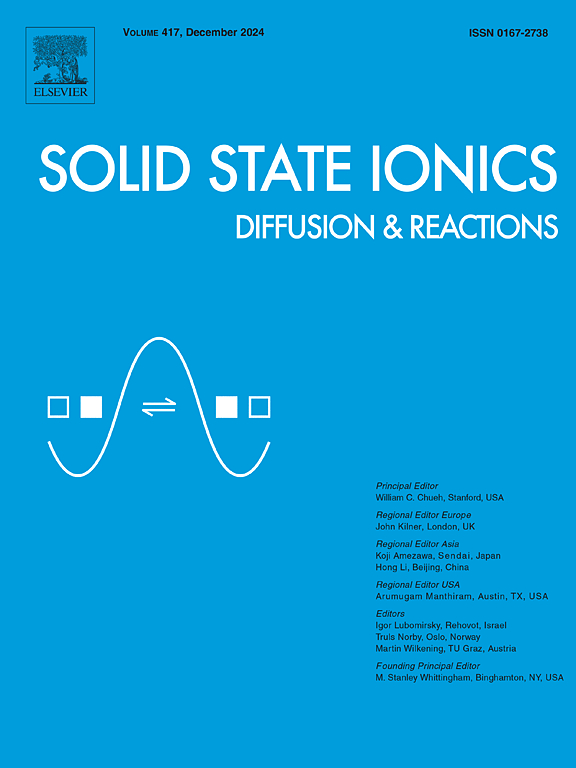立方钙钛矿Na和ga掺杂BaZrO3的高氧化离子电导率
IF 3.3
4区 材料科学
Q3 CHEMISTRY, PHYSICAL
引用次数: 0
摘要
固体氧化物离子电解质(soe)在决定固体氧化物电化学器件的工作温度、成本和寿命方面起着至关重要的作用。最具竞争力的国有企业通常存在于立方结构氟化物(例如,基于zro2和基于ceo2)和钙钛矿(例如,基于lagao3和基于Ba(Zr,Ce) o3)中。然而,在固态离子学的历史上,新的高导电性SOE系统的发现非常有限。在这里,我们探索了一种新的立方结构钙钛矿,Ba1-xNaxZr1-xGaxO3-x (BNZG),作为潜在的氧化离子导体。与最先进的钙钛矿电解质La0.8Sr0.2Ga0.8Mg0.2O2.8 (LSGM)相比,BNZG具有相当的体积离子电导率(600°C时为0.01 S/cm),同时降低了40%的Ga含量。此外,与另一种广泛研究的钙钛矿电解质BaZr0.8Y0.2O2.9 (BZY)相比,BNZG在低温下表现出优异的烧结性能。从头算分子动力学(AIMD)模拟表明,BNZG是一种氧化离子导体,特别是在高温下,高氧化离子输运数(>0.99)和不受氧和水蒸气分压影响的电导率也证实了这一点。此外,BNZG在CO2/空气中稳定,并且与La1-xSrxCoO3-δ等活性钙钛矿阴极兼容,无需使用阻挡层。我们还表明,由Ga偏析引起的高晶界电阻可能是BNZG在中温固体氧化物电池中应用的一个关键问题。本文章由计算机程序翻译,如有差异,请以英文原文为准。
High Oxide-ion Conductivity in Cubic Perovskite Na- and Ga-doped BaZrO3
Solid oxide ion electrolytes (SOEs) play a crucial role in determining the operating temperature, cost, and lifetime of solid oxide electrochemical devices. The most competitive SOEs are typically found in cubic-structured fluorides (e.g., ZrO2-based and CeO2-based) and perovskites (e.g., LaGaO3-based and Ba(Zr,Ce)O3-based). However, the discovery of new high-conductivity SOE systems has been very limited in the history of solid state ionics. Here, we explore a new cubic-structured perovskite, Ba1-xNaxZr1-xGaxO3-x (BNZG), as a potential oxide-ion conductor. Compared to La0.8Sr0.2Ga0.8Mg0.2O2.8 (LSGM), a state-of-the-art perovskite electrolyte, BNZG exhibits a comparable bulk ionic conductivity (∼0.01 S/cm at 600°C) while reducing Ga content by 40 %. Additionally, compared to BaZr0.8Y0.2O2.9 (BZY), another widely studied perovskite electrolyte, BNZG shows excellent sinterability at lower temperatures. Ab Initio molecular dynamics (AIMD) simulations suggest that BNZG is an oxide-ion conductor, particularly at higher temperatures, which is also confirmed by high oxide-ion transport number (>0.99) and conductivity independent of oxygen and water vapor partial pressures. Furthermore, BNZG is stable in CO2/air and compatible with active perovskite cathodes such as La1-xSrxCoO3-δ without the use of barrier layer. We also show that the high grain-boundary resistance originated from Ga segregation could be one critical issue for BNZG application in intermediate temperature solid oxide cells.
求助全文
通过发布文献求助,成功后即可免费获取论文全文。
去求助
来源期刊

Solid State Ionics
物理-物理:凝聚态物理
CiteScore
6.10
自引率
3.10%
发文量
152
审稿时长
58 days
期刊介绍:
This interdisciplinary journal is devoted to the physics, chemistry and materials science of diffusion, mass transport, and reactivity of solids. The major part of each issue is devoted to articles on:
(i) physics and chemistry of defects in solids;
(ii) reactions in and on solids, e.g. intercalation, corrosion, oxidation, sintering;
(iii) ion transport measurements, mechanisms and theory;
(iv) solid state electrochemistry;
(v) ionically-electronically mixed conducting solids.
Related technological applications are also included, provided their characteristics are interpreted in terms of the basic solid state properties.
Review papers and relevant symposium proceedings are welcome.
 求助内容:
求助内容: 应助结果提醒方式:
应助结果提醒方式:


